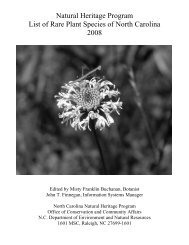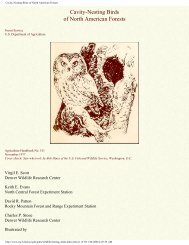Natural Heritage Program List of Rare Plant Species - Rawlings ...
Natural Heritage Program List of Rare Plant Species - Rawlings ...
Natural Heritage Program List of Rare Plant Species - Rawlings ...
You also want an ePaper? Increase the reach of your titles
YUMPU automatically turns print PDFs into web optimized ePapers that Google loves.
Scientific Name Common Name Status Rank<br />
Province: Habitat (Counties <strong>of</strong> occurrence) N.C. U.S. N.C. Global<br />
Physcia pseudospeciosa A Rosette Lichen SR-T - S1 G1G2<br />
M: mossy rocks in open woods<br />
and high elevation granitic and<br />
sandstone rock outcrops<br />
(Jackson)<br />
Porpidia diversa Boulder Lichen SR-T - S1 G2G3<br />
M: high elevation rocky summits<br />
Porpidia herteliana Boulder Lichen SR-T - S1? G2G3<br />
M: high elevation rocky summits<br />
Sticta limbata Powdered Moon Lichen SR-D - S1 G3G4<br />
M: on bark and over mosses on<br />
trees and rocks<br />
Teloschistes flavicans Sunrise Lichen SR-P - S1 G4<br />
C: on branches <strong>of</strong> trees and shrubs<br />
or on the ground in open areas,<br />
especially near the coast<br />
(Brunswick, Carteret, Onslow)<br />
Usnea angulata Old Man's Beard SR-P - S1 G3G5<br />
M: on branches <strong>of</strong> juniper on high<br />
elevation granitic domes<br />
(Jackson, Macon, Swain*)<br />
Xanthoparmelia monticola A Rock-shield Lichen SR-L - S2? G2?<br />
M: high elevation rocky summits<br />
(Bun combe*, Haywood*,<br />
Jackson*, Mitchell*,<br />
Transylvania*)<br />
NORTH CAROLINA PLANT WATCH LIST<br />
The North Carolina <strong>Plant</strong> Watch <strong>List</strong> includes plant species which are rare or otherwise threatened with<br />
serious decline, but for which current information does not justify placement on the main list (E, T, C, SR,<br />
or SC). Watch <strong>List</strong> species are additional indicators <strong>of</strong> significant habitats, and their presence should be<br />
considered in planning natural area protection efforts, though with less weight than higher priority rare<br />
species and natural communities. The NC NHP maintains paper files on these species, but does not include<br />
them in its map and computer files. <strong>Plant</strong>s placed on this list fall into a number <strong>of</strong> categories, discussed<br />
below. NC NHP requests additional information about these species, in order to clarify their status and<br />
reclassify them into other appropriate categories.<br />
Reasons for the current placement <strong>of</strong> rare species on the Watch <strong>List</strong> rather than at a higher rarity status<br />
(Endangered, Threatened, Candidate, or Significantly <strong>Rare</strong>) vary . The taxonomic validity <strong>of</strong> some <strong>of</strong> these<br />
species is currently in doubt. For others, NC N HP lacks adequate documentation <strong>of</strong> their historic or present<br />
occurrence in North Carolina. Others are known to be rare in North Carolina, but it appears that they are not<br />
native to the state. For most species, however, their actual rarity is poorly known and we are requesting more<br />
data before such species receive a higher, and more formal, rarity status. A field survey form is provided in<br />
the back <strong>of</strong> this document. We request that people fill out this survey form and mail it to NC NHP after<br />
visiting occurrences <strong>of</strong> these species.<br />
The Watch <strong>List</strong> has been divided into seven categories as follows. A list <strong>of</strong> Potential "New-to-North<br />
Carolina" species is located after the Watch <strong>List</strong>.<br />
Watch Category 1 (W1 - rare, but relatively secure) includes rare species whose status in North Carolina<br />
is relatively well known and which appear to be relatively secure at this time. While still notably rare, these<br />
species do not currently require site-specific monitoring and so are not on the main list (E, T, C, SR, or SC).<br />
Many <strong>of</strong> these species were formerly on the main list; they are retained in this category because they require<br />
a lower level <strong>of</strong> continued monitoring to ensure their long-term security. NC NHP maintains paper files on<br />
W1 species and requests occurrence data.<br />
75




